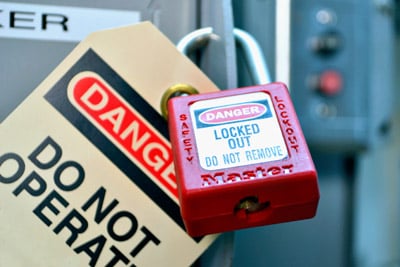When it comes to electrical safety practices, Chad Soucy has a thing or two to share about the experiences that have shaped his career and safety mindset.
In the following interview, Chad reveals his thoughts on the good, the bad, and the ugly practices in safety training, what can be improved upon, and how businesses can leverage technology to boost learner confidence, leading to better and safer job performance.
Q: What does safety training mean to you? Do you have any personal philosophies around safety?
Safety training is very personal to me.
On Dec 15, 1996, I was involved in a near-death arc flash event that totally changed my life forever.
I am very lucky to be alive to tell the tale, but unfortunately, it took such an experience for me to realize that I wasn’t working safely.
Since that day, I’ve made it my mission to dedicate my whole career to focusing on having a safety mindset. I worked hard to build my career alongside learning the electrical fundamentals necessary to understand electrical hazards and how to reduce the risk of electric shock and arc flash. Now, I try to pass on that information to others.
Read about the Arc Flash Event that led to my Safety Mindset.
Q: What, in your opinion, is lacking in safety training today?
The connection between OSHA regulations 1910 general inquiries, 1926 construction, and the NFPA 70E is lacking.
OSHA is the law for electrical safety, which empowers the NFPA 70E to publish ‘how to practice electrical safety.’
In my opinion, there is a lack of practical application, so employers are forced to offer employees static training based on memorization that is very difficult to apply in an everyday situation.
Q: What do you think the industry as a whole could be doing better to increase safety competencies?
The industry as a whole (all electrical disciplines including electrical appliances within HVAC, solar, plumbing) should be training employees to be Qualified as defined by OSHA and the NFPA 70E.
According to the NFPA 70E:
“A Qualified Person shall be trained and knowledgeable in the construction and operation of equipment or a specific work method and be trained to identify and avoid the electrical hazards that might present with respect to that equipment or work method.”
And the NFPA 70E 110.6(A):
“Training requirements apply to employees exposed to an electrical hazard when the risk associated with that hazard is not reduced to a safe level by the applicable electrical installation requirements. Such employees shall be trained to understand the specific hazards associated with the electrical energy.”
What Administrators, Managers, Supervisors, and Electrical Personnel roles can be doing to train towards Qualified is to focus on training according to the following hierarchy of Risk control methods:
-
-
- Elimination (most effective)
- Substitution (most effective)
- Engineering controls (most effective)
- Awareness
- Administration controls
- PPE
-
Q: What do you think employers could be doing better to increase safety competencies?
All employers and staff associated with estimating, planning, and administration of personnel working on or around electrical hazards need to be Unqualified / Qualified as stated by the NFPA 70E.
Employers need to understand how to train and develop an ESP (electrical safety plan) using the hierarchy of risk controls. Risk assessment development and training are essential.
NFPA 70E 110.5 (A) General:
“The employer shall implement and document an overall electrical safety program that directs activity appropriate to the risk associated with the electrical hazard.”
Q: What are some of the most common unsafe practices you see in the field today?
The most common unsafe practice I see in the field today is Lockout and Tagout Troubleshooting.
The Intention to work safely (de-energized/energized state) is often misconstrued and must follow the understanding of OSHA 1926 construction and 1910.147 general inquiries— this is critical.
There is rarely any reason to work on live power during construction. Maintaining/maintenance on equipment is a different story and often requires the power turned on to test live power on the components with a digital multimeter (DMM).
These tasks are commonly at cross purposes and affect the approach electricians develop when switching from constructing circuits to maintaining them.
When I was a Journeyman, I subscribed to some flawed practices and then passed them down to electrical apprentices. I still see this often associated with maintaining electrical appliances, and this permeates throughout the electrical industry.
Q: It is well-understood that unsafe practices can lead to an increase in operational costs and injuries. Can you talk about the impact that unsafe practices can have on business/ brand reputation?
Employers are responsible for providing a safe workplace. The employer determines if the employee is a Qualified person, also providing training for associated tasks.
Electrical contractors are often given opportunities to bid on mid-level to large projects due to their safety record. This means that the Workers Compensation Board rates the employer safety record with a percentage of the company’s man-hours, making it more expensive for the employers to operate if they are deemed unsafe and less costly if they have a good safety record.
To sum it up, businesses that don’t focus on proper safety training and procedures cannibalize their bottom line.
Q: Do you have any personal anecdotes to share about a company’s brand reputation suffering from inadequate safety practices?
Often, safety officers are seen as supervisors that try to catch you doing something that affects your employment, rather than admit they failed to work together building an (ESP) Electrical safety plan.
A company’s safety culture is what the employees are doing when no one is looking.
Q: Any companies you’ve seen who are modeling safety right?
Electrical companies offering yearly NFPA 70E training onboarding and reoffer every three years are doing things right.
The trend for electrical accidents and fatalities show a decrease in events (arc flash, electric shock fatalities, etc.) every three years after the NFPA 70E is adopted. This can be attributed to better awareness.
Employers that do things right are implementing an electrical safety plan and updating the ESP’s when the latest version of the NFPA 70E is released.
Q: With 3D simulation/VR technology, learners today can now build safety competencies in a risk-free environment. As someone who’s been in the industry for over 30 years, what are your impressions on the effectiveness of learning this way compared to how you learned?
I think that 3D training simulations are the best approach to working with electrical hazards.
Since simulations remove real-life risks, students can truly focus on learning rather than fearing the consequences of an unsafe action. This allows trainers to concentrate on coaching and mentorship while learners build their confidence and trust in the process.
Training in my day was limited to finding a Journeyman that was willing to explain things.
Often, I was left out of the conversation— possibly because I asked too many questions, which may have detracted from actual work. Usually, another apprentice and I would discuss/debate a variety of practices until we resolved a problem.
For the most part, the Journeymen were unwilling to offer information and guidance, though I still remember the ones that provided information, advice and helped me in my career. Those people influenced me to be the Journeyman I decided to be— one that people will remember!
Q: Talk about the importance of building up your technicians’ confidence when it comes to working safely.
When I work with any level electrician, I expect them to subscribe to our “community of experts,” dedicated to understanding electrical hazards and reducing them to a safe level.
Even though we are at different levels, everyone can participate when we all understand and agree there is no compromise on electrical/safety.
Electrical personnel must be aware of the dangers of working with electricity, whether construction or maintenance, and it is essential to develop a healthy respect for electricity.
An apprentice that has chosen the electrical trade for their profession understands they have a lot to learn, and part of the learning process is making mistakes.
To build up confidence, I treat my apprentices with respect. We build trust as we go. I’ll do things like ask them what they think about a certain task, give them a chance to think critically, let them participate in the decision-making process, and allow space to make errors safely.
I think it’s very important to engage young people because they have a lot to offer the trade.
The more trust and autonomy we build together, the more comfortable they will be with making mistakes. Mistakes are teaching and coaching opportunities that are necessary to advance their skills.
Q: How is simulation training helping to funnel more confident technicians into the workforce?
Electrical training is rooted in extrinsic motivation. Students like to get instant feedback, which is difficult to do with OJT.
Electrical Journeymen are expected to train electrical apprentices, however not every Journeyman can, and some don’t want to. The ones that do want to will often tell their apprentices to forget what they learned in trade school, or they make their apprentices wait… and wait… and wait… for opportunities to get their hands dirty. This can be very slow, unmotivating and confidence depleting for the electrical apprentice.
In my opinion, the electrical construction trade is very hands-on, so the 3D simulations with Interplay are the perfect solution to the lack of practical application I mentioned earlier.
The simulations look and feel realistic, provide real-time feedback on errors, and the subject matter is comprehensive. All of the above factors contribute to us giving our apprentices the tools they need to bypass certain industry training attitudes that are not serving the confidence levels of learners.
Technology like this can allow a greater number of apprentices to safely build up skills, make errors, take control of their learning, and confidently choose a pathway to the career in electricity that they think is best for them.
Whether in HVAC, solar, plumbing, electrical appliances, or electrical safety, simulation training contributes to funneling far more confident techs into the industry that work safer and perform better, improving the reputation of the companies they work for.

Chad Soucy
Interplay Learning Electrical Expert
Chad is Interplay’s electrical expert and is a Master Electrician. Chad has progressed as an electrical professional throughout his career, with early beginnings in rewiring/wiring homes to QA/Commissioning plants, honing his skills in all aspects of the electrical trade along the way. He transitioned his career through Residential, Commercial and Industrial sites, and in 2012, further expanded on his mission to lifelong learning in becoming an electrical instructor. He continued on this path as an online course developer and is steadfastly committed to electrical safety and sound adult learning theories.




